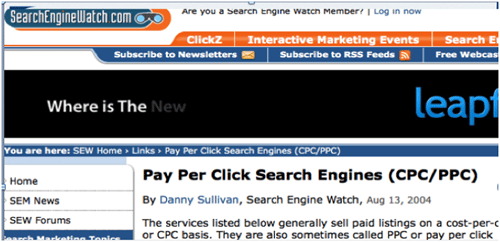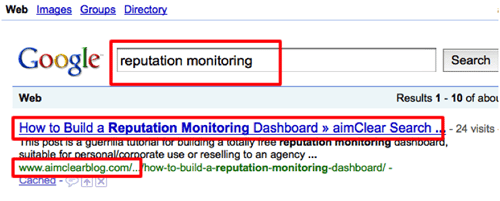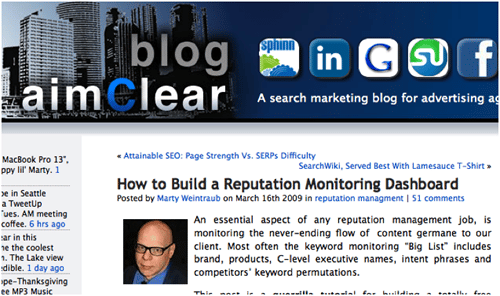
Since the onset of personalized search, frustrated SEO sharpshooters have sought tactics to somehow get a grip on the ensuing chaos. Now that most users get uniquely-customized search results (SERPs), the days of search engine optimization measurable in the SERPs are long gone.
This post offers a useful method to optimize for micro-demographics in a way that, not only neutralizes, but also assertively exploits personalized search to the SEO’s benefit, one user at a time. Even better: there is no way Google or any other engine will ever defeat this tactic. Got ya’ interested? Read on for an accidental antidote: SEO for personalized search.
Background Before Goodies
At SES New York 2007, Danny Sullivan interviewed Marissa Mayer, Vice President, Search Products & User Experience at Google. The SEO world was turned upside-down that memorable March morning by her long-anticipated announcement that Google’s search engine results pages (SERPs) were now “personalized,” meaning every user receives customized results based on Google’s data mining of users’ behavior. We had noticed subtle changes in the SERPs prior. It was early but there were “over 10 million personalized results” at the time. Yahoo & Bing followed suit.
SEO as we knew it was no longer possible because it wasn’t feasible to run ranking-reports to quantify success. Previously we all ran ranking reports like WebPosition Gold, which yielded absolute documentation of where a keyword ranked in relation to a specific page in the SERPs.
Genesis of a Guerrilla Tactic
In 2006 we started linking out to other people’s blog posts when creating quotes for services for prospective clients. Little did we know the tactic would ultimately lead us to a killer technique to circumvent serious problems presented to SEOs by personalization.
The tactic solved a number of problems. First it helped us solidify concepts for customers. Search marketing has a ton of tiny details, which often need explanation. Linking out to articles to clarify served the purpose of client-empowerment well because it took little of our time. We also learned that our requiring study of our new business-leads, as a prerequisite to our taking the job, is a cool method to vet prospective clients’ compatibility with our shop.
Our thinking was that any potential customer unwilling to read background material to explain things would make a rotten client in the end anyway.
In time we got tired of giving away our brand, to other bloggers’ posts, as we linked out from proposals. The result was that we started AIMCLEAR Blog, initially as an FAQ destination URL for service pitches.
This proved even more effective when we started to tag proposals at the individual pitch level (?source=who-we-pitched-first-name-last-name). It does not matter if our blog got a lot of traffic.
We only cared that the right visitor saw our stuff–the prospect we sent from out proposal. Using the blog as such also branded the agency as a thought leader and our “close rate” went up significantly.
When chatting on the phone or across the table, I started telling customers to Google keywords in combination that pretty much guaranteed they’d see our post as the number 1 result. Here’s an example: “Search for AIMCLEAR reputation monitoring.” Then I’d say, “OK now, click on the first result.”
Then we would discuss the post. It almost always worked as the most efficient method to lead folks to a post anyway. Even if we did not own the personalized #1 for a certain phrase, we could always feed people some 3-4 word phrase that got us to the top of their SERPs. After all, we’re SEOs :).
Actually I’d been doing this for years, mostly because it’s the easiest way for me to find our content, which I’ve lost track of by and large. Ever since we’ve sent all sorts of people to their very own personalized Google SERPs to click on our blog. It’s so easy.
The Big “Ah Hah” Moment!
In September we trained a company in Detroit for 4 days. Over the course of each day it made sense to use AIMCLEAR Blog to clarify concepts like Universal Search, Personalized Search, Facebook PPC, etc… Time after time I’d invite all 6 people in the room “Google AIMCLEAR this” or “AIMCLEAR that.” It’s probable that each trainee Googled and clicked on between 25-30 blog posts to locate posts intended to clarify content.
After the session, I was on the phone with one of the trainees re-explaining the term “Content Marketing.” She blew me away by offering that she had “just searched for ‘content marketing’ and AIMCLEAR Blog had the #1! Dude, we had barely ever written using those words as a blog title or built anything to achieve high organic prominence for this competitive phrase. Google was skewing her results based on the dozens of times she had searched and clicked at my direction. Obviously her history indicated to Google that she was very interested in our site.
The Antidote: SEO for Personalized Search
The solution to optimizing SERPs, which are customized based on an individual user’s affinities, is to influence that user’s offline behavior. Think of AOL back in the day. They’d advertise where the call to action was to “visit AOL, keyword = ________.
Getting users to click on your website’s listing in the search engine results teaches the search engine that the user “likes” your site. After very few clicks, Google learns that the user looks to your site as an authority for that and closely related topics. Use this to your advantage!
- During phone calls say “search for THIS and click on It.”
- Tell potential customers at meetings & pitches.
- Email links to unpersonalized SERPs with instructions to click on the results.
- Put SERPs link in blog Posts (we do and it works :)).
- Never miss a chance to direct folks to content by way of SERPs/click.
- Making up words usually works, I.E. tell people “Go to Google and search for something like, “The Mighty Rankinstanker.” Say, “Click on the first result.” In this case the user has demonstrated to the engine he/she ‘likes” SearchEngineLand.
- Go mass market. Make the call to action. Advertise: Put “Go to Google.com, keyword ________ in your radio ad.
Personalized search was inevitable. There are various arguments as to why it’s good or bad, but obviously there are inherent challenges for SEOs. A great way to attack the issue is to influence users in how they use search engines. Google and other engines will never be able beat the approach of optimizing users pre-click behavior instead of only web pages.












